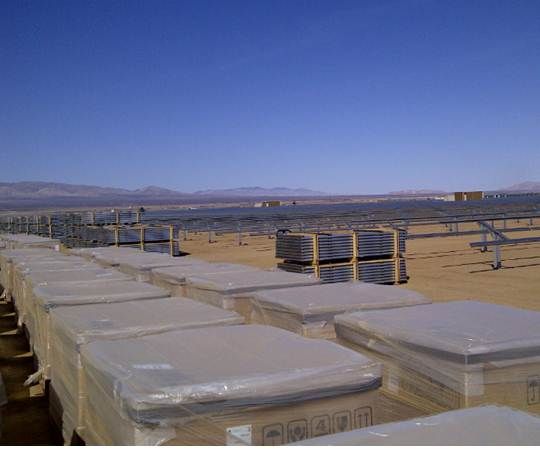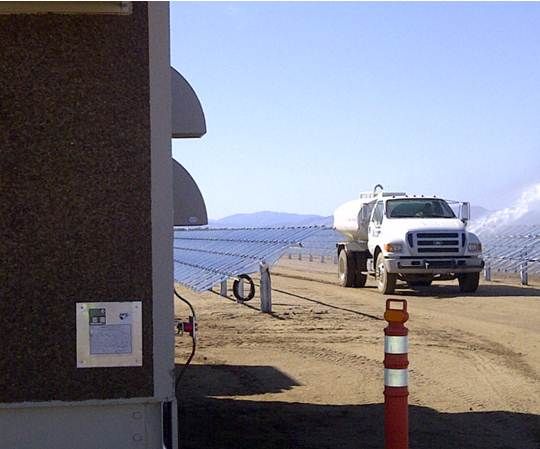Antelope Valley Solar Ranch One (AVSR1), an enormous 230-megawatt (AC) solar power plant, continues to rise from the desert floor, despite obstacles coming from many directions. First Solar continues to provide engineering, procurement and construction (EPC) services for Exelon and has said the project is 28 percent complete and on track for inauguration of its first phase in September.
None of the 3.7 million cadmium telluride panels had been installed as of the project’s March 2 press preview, but thousands of 50-panel cartons sat on pallets around the plant’s field, on which a quarter of the project’s 90,000+ posts and a quarter of its 90,000+ brackets had been installed.
Sixteen percent of the AC line trenches and 13 percent of the DC line trenches had been dug. A quarter of the 49 electronics vaults were built. The substation and the operations and maintenance building were not built, but components were positioned.

More importantly, 200 of the 350 people who will eventually be employed to build the project have been placed in full-time jobs, and almost two-thirds of those jobs have gone to people from nearby communities in and around the Antelope Valley, where unemployment for the largely working-class population has approached fifteen percent during the recession.
Over a quarter of a million dollars in purchase orders are out with local vendors, a local dirt moving company continues to do major hauling, and employee lunches are being bought daily from three local venues that were notoriously quiet before the arrival of the AVSR1 project.
Struggles with activists in the surrounding communities last summer threatened to delay groundbreaking long enough to keep the project from qualifying for its federal loan guarantee continue. Still, First Solar broke ground just behind schedule.
After ground was broken, local activists raised a cry about dust, about the project’s appearance, about the conduct of First Solar’s security people and about the company’s safety and decommissioning plans. Construction nevertheless went ahead.
Copper wire valued at thousands of dollars was stolen from the project grounds over the New Year’s holiday weekend. The roof of a temporary office building was almost blown off by ferocious desert winds in early February. Biologists had to learn to contend with the venomous Mojave Green rattlesnake and tarantulas. But still, construction proceeded.

Challenges from the hard desert terrain temporarily prevented First Solar from meeting terms defined by the Los Angeles County conditional use permit (CUP) and almost prevented the company from meeting its last loan guarantee deadline. Yet First Solar kept building.
After the CUP was granted by the county and before ground was broken, the surrounding communities broke out in bickering over a rumored community benefits package. When the actual $280,000 benefits package was announced by First Solar two months ago, the bickering grew louder. Yet construction went ahead.
The most recent questions about the loan guarantees forced First Solar and Exelon to postpone finalization of the project’s sale, yet First Solar keeps building.

First Solar estimates AVSR1’s 230 megawatts “will produce enough electricity to meet the annual energy needs of about 75,000 average homes, [...] the equivalent of taking about 30,000 cars off the road” in terms of greenhouse gas emissions.
Antelope Valley, said First Solar Vice President Jim Woodruff, was and remains an attractive site for solar power plants.
The high quality insolation of the high desert is obvious. Reports suggest the valley gets well over 300 and perhaps as much as 330 or more sunny days every year.
The Southern California Edison (SCE) Tehachapi Renewable Transmission Project (TRTP) offers ample proximal transmission just across the valley from AVSR1. TRTP will eventually be capable of carrying 15,000 megawatts of wind energy-generated electricity from the Tehachapi Mountains a few miles to the north. It is estimated those lines could offer as much as 80 percent of that capacity for solar energy-generated electricity because of the way the two sources’ loads vary over the course of an average day.
Another advantage that attracted First Solar, Woodruff said, was that the land was “previously disturbed agricultural land.” That, he explained, significantly reduced environmental impact concerns. “There are no threatened or endangered species on the site, and the project will not use water for electricity generation,” First Solar has reported.
Ample rural roads and other infrastructure, a hungry and ready local workforce, and the strong support of local politicians and the business community, Woodruff said, add to the area’s appeal.
First Solar has just broken ground as the EPC provider on the first phase of NRG Energy’s 92-megawatt Alpine Solar project just a few miles down Highway 138 from AVSR1. Local community leaders report various solar power plant developers have approached them with 26 more project proposals.
First Solar hopes Governor Jerry Brown, whose administration’s legacy may be putting and keeping California on track to obtain a third of its power from renewable energy by 2020, will attend the AVSR1 inauguration in September and throw the switch to send its first power to the SCE grid.



